The Restoration of Tillinghast’s Southward Ho Country Club
by Phil Carlucci
May, 2023
On a Friday morning in the spring of 1954, readers of the Brooklyn Daily Eagle flipped through their newspapers and found something that had just about vanished over the previous two decades – good news in the local golf industry.
Southward Ho Country Club, a 1920s-era A.W. Tillinghast design on the south shore of Suffolk County, was on firm financial ground (“Back On Links,” the Eagle headline read) thanks to the generosity of one of its members. Nearly ten years prior, in the waning days of World War II, Horace Havemeyer bought the property from the bank and allowed the struggling club to continue operating without the burden of severe financial stress. Now in “one of the nicest neighborly deals,” Havemeyer sold the Bay Shore property back to the club. His intervention rerouted Southward Ho’s trajectory and rescued it from the same decline and neglect that turned other Roaring Twenties courses into suburban street grids, homes and schools. The Havemeyer Invitational is still played today in his honor.
Decades later in the spring of 2022, Long Island golfers flipped through their social media feeds – a modern-day stand-in for the weekly golf column – and found equally encouraging news amid a collage of photos on Instagram. Bird’s-eye drone shots captured a restoration near its end at Southward Ho, and much of the imagery focused on its most dramatic feature – a Hell’s Half Acre sand trap that bisects the course’s 11th hole. With rows of white sand angled into a V-shape as they curl around a half-dozen mounded grass pads, Hell’s Half Acre is the central hazard on the 551-yard par-5 and, whether playing the hole or just admiring it from the sky, the centerpiece of Southward Ho’s Tillinghast-inspired revamp.

The resurrected Hell’s Half Acre hazard upon its completion in 2022. (Photo credit: Ray Bangs)
The hazard also serves as the exact midpoint of Southward Ho’s most captivating stretch, a seven-hole stroll that begins at the distinctive dogleg eighth, ends at a Tillinghast Reef and waves at the club’s landmark windmill along the way. A brief halftime to pause and tip your hat to the revered designer and those who brought his work back to life.
Southward Ho is “singularly unique,” as described in the 2016 master restoration plan conceived by Tillinghast historian Philip Young and architect Joel Weiman. Just a half-mile from Great South Bay, Southward Ho is Tillinghast’s lone rendition of a British seaside course, Young says. His work was mostly inland, but here on the western edge of Bay Shore, Tillinghast’s 1923 design was exposed to powerful Atlantic winds and emphasized the ground game with spacious fairways, broad entrances and runoffs around the greens. Amid a Long Island course-building boom where land was developed and even crafted from the muddy bottoms of local waterways solely for the pursuit of golf (Lido, still in its infancy, sat 20 miles west, Timber Point only five miles east), Tillinghast was there in Bay Shore, walking the Southward Ho grounds, overseeing the construction work. When finished he left the club with a rarely seen trifecta – a Hell’s Half Acre bunker, a Little Tilly par-3 and a Reef, all on one course.
Young’s goal was to restore Tillinghast’s design intent. “The one shot that tells the story in golf is the shot to the green,” Young says, and at Southward Ho, Tillinghast created a course where the approach shots are the most fascinating. Instead of building holes that demanded long carries or asked players to sidestep penal hazards off the tee, the designer provided most tee shots with ample amounts of landing space. Players were free to explore and take comfort in all that short grass, though they quickly discovered Tillinghast set out to reward only the shots that reached particular lanes within the fairways. Those shots were granted access to open entrances, helpful contouring and room for creativity.
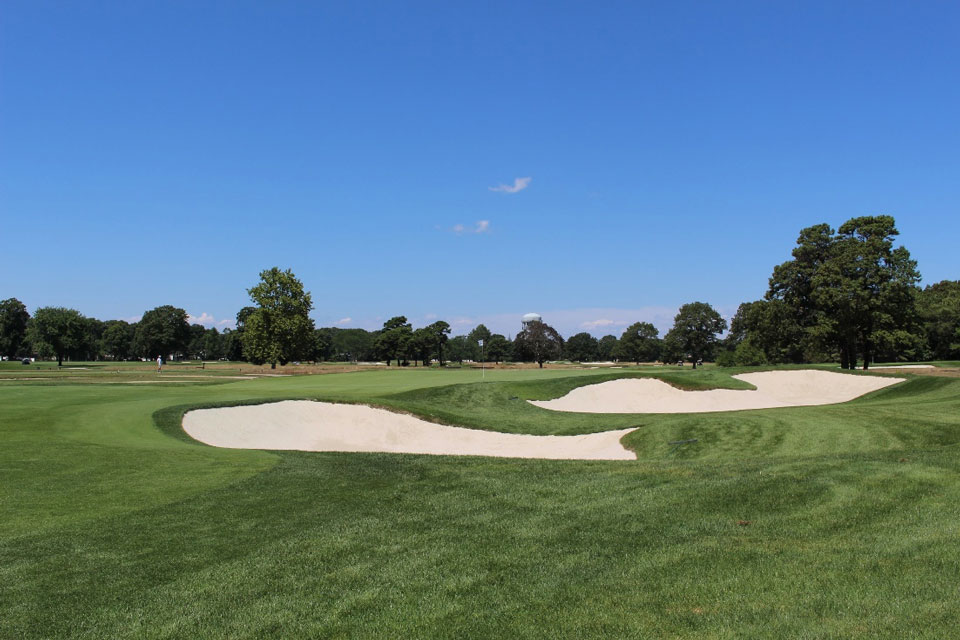
A common sight at Southward Ho when approaching from the wrong side of the fairway or rough – large bunkers guarding a small target.
Recapturing that design philosophy meant reversing years of narrowing, tree planting and green loss. The master plan called for expanding the fairways to bring dormant routes and angles back into play and reopening the interior of the course to unleash the wind as a perpetual nuisance no longer buffered by corridors of trees. It also focused on recovering parts of the green surfaces – some were stretched almost all the way back to the edges of adjacent bunkers, others were pulled in front to broaden the entrances. Young, Weiman, superintendent Jim Stewart and a club subcommittee relied on a newly discovered 1938 aerial photo as the blueprint. This image, Young says, shows Southward Ho, then a largely treeless, wind-swept plain, as it was originally designed and built 15 years prior by Tillinghast. Aerial photos taken later during the turbulent post-WWII years depict segments of the course in varied stages of change or decline.
Weiman and Stewart carried out most of the work over the course of several seasons. One large piece of the overall project was a major renovation of Southward Ho’s 70 bunkers, especially the many greenside traps that play such an integral role in Tillinghast’s design. Some of their steep front faces had grown by feet, the result of years of club-tossed sand accumulation left unchecked. Not only were those faces cut back down to size, the bunker floors were raised as well.
Hell’s Half Acre’s restoration began in the fall of 2021. Roughly 80 yards long and nearly as wide, the hazard is massive, but what makes it so intriguing is its abbreviated history. For much of the time between Havemeyer’s 1954 sale and its 2022 reopening, Southward’s Half Acre was gone, buried. It existed merely as a rumpled stretch of fairway grassed over and narrowed, a victim of post-war conditioning and belt-tightening. The restoration excavated, much like an old time capsule, an iconic element that had only seen the light of day for a brief segment of the club’s early history.
+ + + +
Southward Ho’s most compelling seven-hole stretch begins at #8, a par-4 that can surprise, maybe even startle players. There is simply nothing like it over the preceding seven holes. A few of the early holes offer slight bends to the right, but the eighth makes a dramatic 90-degree turn to face a narrow, pond-fronted green. It’s an approach that can leave players feeling uneasy, even if tee shots on the 372-yard par-4 find an ideal position way down the right side, beyond the turn. Look ahead from that spot and you’ll see a two-tiered green protected by water and sand with the course perimeter running up the left side. (Imagine in Tillinghast’s day a much more bucolic setting beyond the course boundary than today’s Montauk Highway.) There’s no subtlety on this approach – either hit a great shot to an elusive target or card a demoralizing number.

An offset green on the par-4 eighth leaves even strong tee shots with a diagonal approach to a two-tiered surface.
Of course, a well-executed tee shot eases the burden on the approach, but that’s much easier said than done. The green here is offset from the bulk of the fairway, so only tee shots that reach the farthest limits of the fairway will be rewarded with a dead-straight look at the flag. Everyone else will approach on a diagonal. But the tee faces the ocean and Southward Ho’s prevailing wind – just reaching the dogleg is no guarantee. And once you turn to make that perilous shot at the green, you’re now battling a crosswind.
Ahead at #9 is Little Tilly – or, more appropriately, Little Tilly 2.0 – which requires another brief sojourn into history.
While Havemeyer was able to stave off the ruinous effects of financial hardship and help Southward navigate through the 1950s and beyond, he could not safeguard the club against newly emerging and evolving perspectives on course design. On Long Island, as the region’s population headed farther east into Suffolk County and filled in many of the open spaces along the way, demand for new golf courses spiked, and mid-century designers like Robert Trent Jones, Alfred Tull and William Mitchell rapidly supplied the Island with “modern” golf courses that appealed to a broader clientele. Southward Ho board minutes in the early 1960s made numerous references to course “improvements” in line with the latest trends. (In fact, Tull visited the club in 1962 to make his own assessment.) By mid-decade the club began filling in traps, adding new ones and focusing energy on reconstructing #9, its diminutive par-3 only a touch longer than 100 yards – Little Tilly.
Young attributes the change to “member hubris.” Players of that era wanted length, just like the holes being built at new clubs nearby, and a tiny par-3 posed too feeble a challenge for the modern game. It didn’t matter that the course designer believed this type of pitch demanded a higher level of skill. “There was no sense or appreciation of Tillinghast at that time,” Young says.
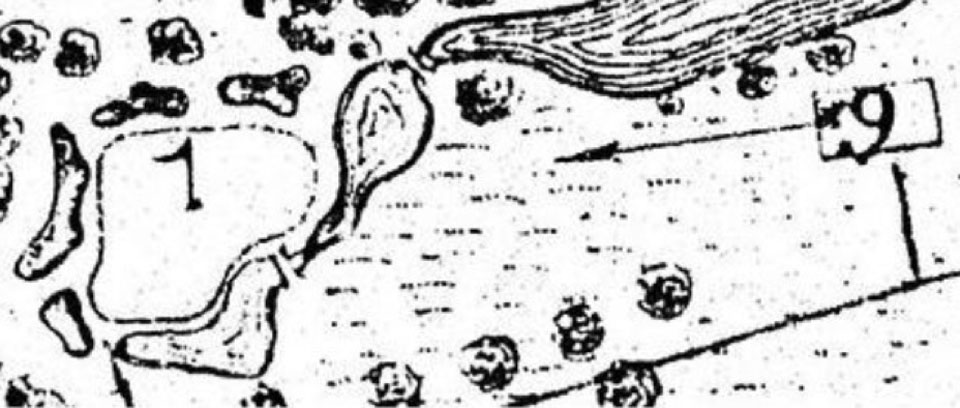
Tillinghast’s drawing of Southward Ho’s Little Tilly par-3. (Image credit: Philip Young)
Today’s Little Tilly plays as long as 160 yards, and from the second-shortest white tees, 126 yards, typically downwind. Shots loft up and over the original green site, now just an anonymous patch of rough. They come down on a severely sloped back-to-front green with a pond in front and two traps on the sides. While the putting surface is among the roomier ones on the course, it feels like a smaller target because short and long, even in the slightest, are brutal misses. Putts from the high back rim are treacherous, to say the least, and overzealous ones can easily slip off the surface. Misses off the back are disastrous.
Restoration of the original #9 is the only part of Young and Weiman’s master plan that has yet to be implemented, and there’s no timetable for its creation. It requires the construction of a new green on the original site, where four large bunkers would fortify the back and right and a pond would protect the front and left. Pre-1960s aerial imagery is murky for that particular section of the course, so any new hole would be a close approximation to what actually was on the ground in the club’s early years. Young’s design is inspired by Tillinghast’s original hole drawings.
After closing its front nine with a par-3, Southward Ho opens the back with consecutive par-5s. (Singularly unique, indeed.) Both play downwind at nearly identical lengths. A strong drive on the 547-yard tenth will soar past the club’s distinctive windmill, which looks over the fairway from the right rough. The best play on the second shot, if distance allows, is a clout over the bunker that presses into the far-right side of the fairway. From there, a massive entrance to the green leaves it exposed to the shot of your choosing, whether it’s a simple pitch or a low runner. If you’ve made it to this spot in two, you’re in full control.
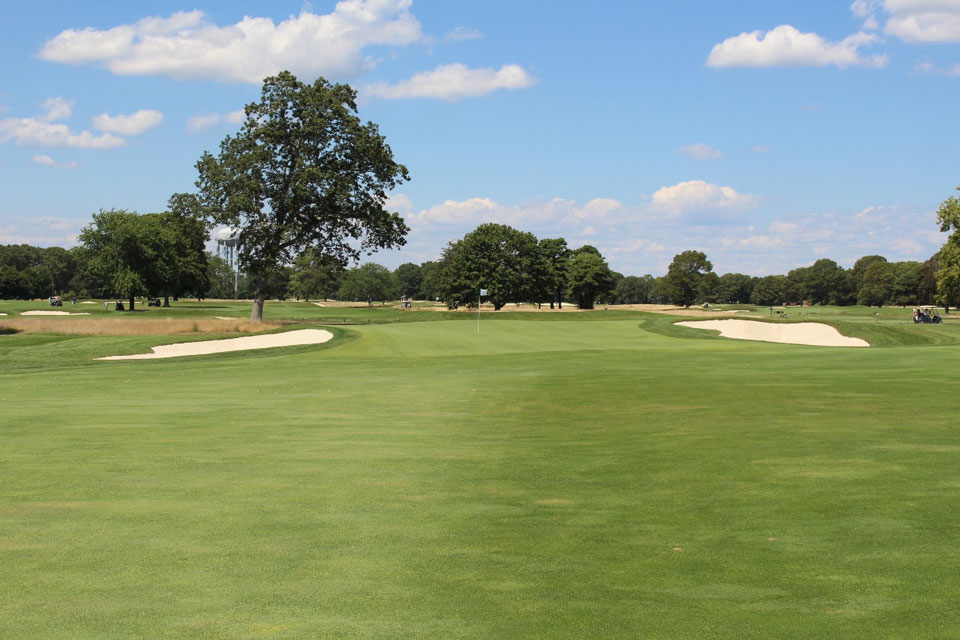
The fairway runs right into the green’s broad entrance on #10, and a well-placed second shot unlocks a variety of options.
But Tillinghast was clever, and his fairway bunker here on #10 is deceptive. It’s not quite as formidable or far into the distance as it appears, yet players might misjudge it and let nerves convince them to avoid the trap rather than challenge it. Up the left side and along the widened fairway edges, the angle home is not nearly as welcoming, and two greenside bunkers frame a green that is unpleasantly narrow from this vantage point.
For such an imposing hazard, Hell’s Half Acre doesn’t make a huge impression on anyone looking out from the 11th tee. Ironically, the eye candy here is the picturesque par-3 fourth, which shares an expanded tee box with #11. About 300 yards into the distance, Southward’s Half Acre appears as an indistinct meld of grass and sand. It takes a drive of that length, give or take a few depending on the tee, to flirt with its front edges. Keep in mind the wind will surely add significant carry to any strong tee shot, so the hazard can impact drives more than expected. (This player used his own restoration of a semi-capable swing to drive one shot around 290 wind-aided yards, and the ball came to rest a few paces short of the sand.)
Just a few years ago, shots here would pinball through a bumpy patch of fairway and rough where the short grass bottle-necked between moguls that still stood as relics of the original hazard. Club historian Tom Draycott says with money and membership hard to come by in the 1950s, the club simply gave up on its Half Acre. It took time and resources to maintain the sand properly and maneuver around the grass pads to keep them mowed and mounded. Plus, constant irrigation issues and livelier golf balls and equipment made the hazard much more intrusive. Tee shots began careening down the parched fairway and into the trap with too much frequency for members to accept. So Southward’s Half Acre was left to nature, its corridors of sand free to grass over around the raised pads.
Following a tee shot into the heart of the fairway, the focus now is on safely eluding the sand. A middle iron propelled by a tailwind would be a relatively simple task if not for the Acre’s mind games. Any deviation from a smooth swing, whether gouging the turf or smacking the ball thin, will send the shot into the teeth of the trap where mound-top, sidehill or blocked lies await. The plan is for the Half Acre to eventually play as a waste area – the sand will be tamped down and firm, and carts will be permitted to drive through it. For now, the new sand is still soft, and riders are directed around the trap.
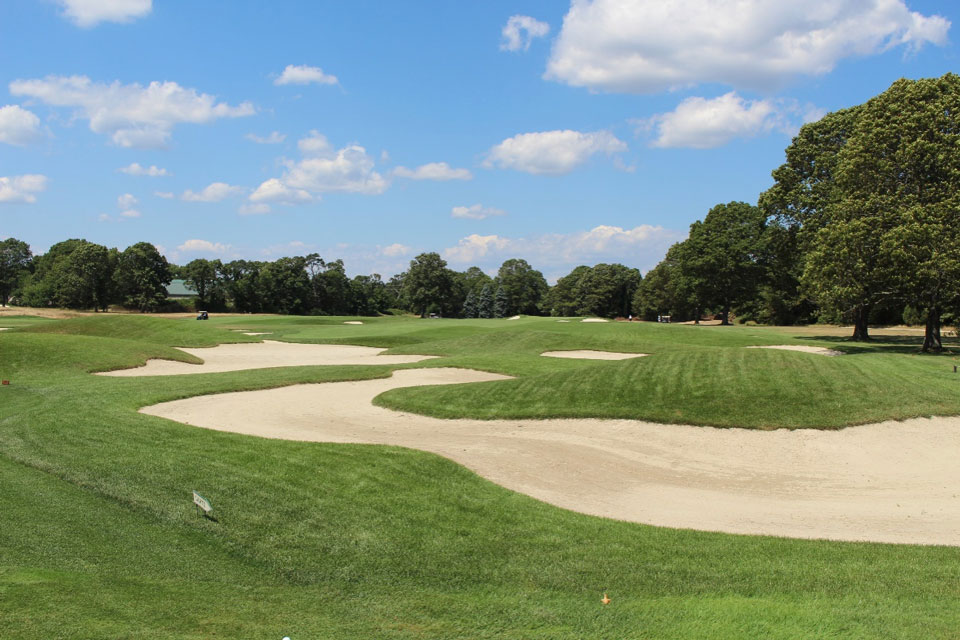
Hell’s Half Acre at ground level.
There’s plenty of room in the far half of the fairway to set up the approach into the green. Ideally, you’ll want to come in from the fairway’s left side with nothing more demanding than a simple pitch. This is another precariously slim Tillinghast green, and it sits slightly perched above four bunkers. Sporting high rims, the green funnels balls off the sides toward the center with speed. Working in tandem, the sand and contouring ensure that any misguided approach leads to an incredibly delicate recovery from off the green.
Southward Ho turns back toward the bay at #12. Even with its two longest tees recessed way back in a chute – a post-Tillinghast add-on – the 349-yarder is the course’s shortest par-4. It can still be played as originally designed by teeing it up on the 287-yard whites. In fact, Draycott says the abbreviated version of the hole has been praised when rotated at times into the Havemeyer event. “The players love it,” he says, because it allows them to go after its “island” green with a skillful pitch – the way Tillinghast would have wanted.
Given Tillinghast’s original hole design, it’s not surprising that #12 features what is likely Southward’s tiniest green. The island here is encircled by sand, not water. Four closely cut bunkers ensure any misses with that finessed wedge or short iron almost certainly drop into the sand. Only the grass margins between traps can keep wide shots up top. Here again, Southward Ho rolls out a landing area so spacious that players might bask too comfortably in its width. But the green is angled toward the fairway’s right edge, and seemingly safe shots in the left fairway or wide-open rough will net a headwind approach over a massive front trap. The play here is over the right-side fairway trap even if your instincts scream the opposite.
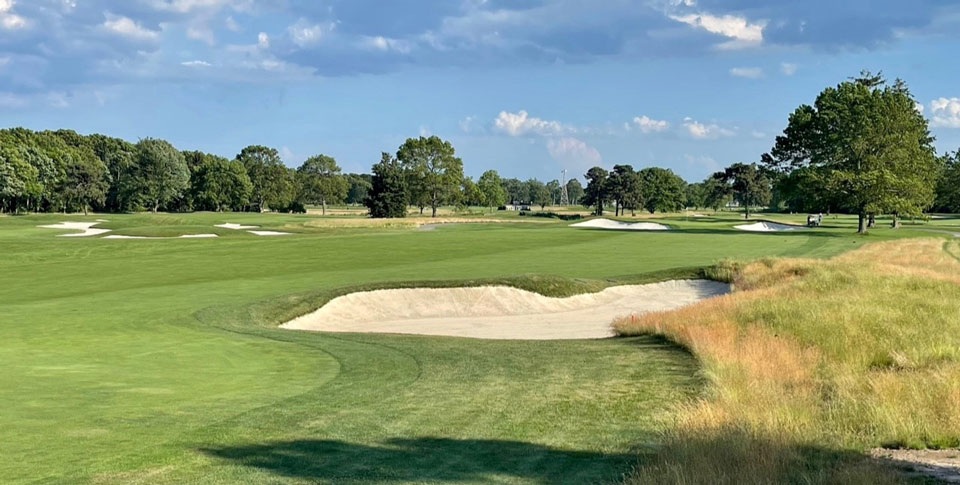
The view from the right-side fairway bunker on #12. Tee shots over the trap have the easiest access to the angled green. Southward Ho’s windmill stands in the distance. (Photo credit: Graeme Baxter)
A similar battle against instinct takes place at the 409-yard 13th. The fairway coaxes you to target the meaty right side where a shot of about 230 yards (tack on 25 yards from the tips) lands well short of a fairway trap. But prime position is farther ahead on the left side – a wind-carried drive of 250-plus bypasses two left-side traps and sets up a clean look at the green.
The nature of the green site doesn’t reveal itself until you stand over your second shot. Like at #8, the 13th green is set off from the bulk of the fairway – most approaches from the widened fairway will come in on a diagonal, the four bunkers working in concert to create the illusion of another green tightly ringed by sand. Only players who reach a lane of left-side fairway will see the green straight on, a view that is much less menacing. Players here also have access to a fairway-cut neck splitting the two front bunkers that, depending on circumstances, could be used to their advantage.
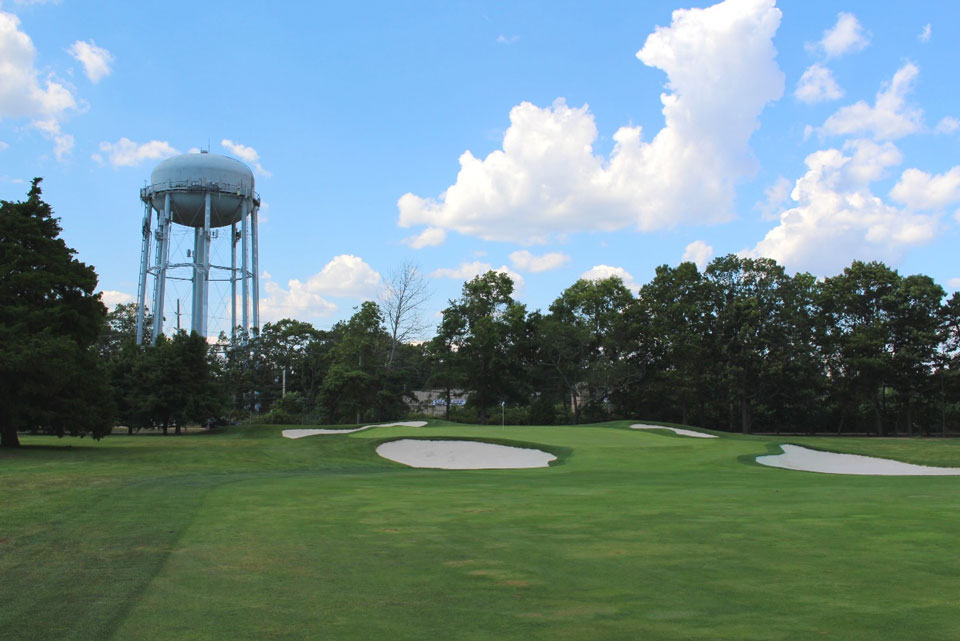
From the left side of the 13th fairway, players have air and ground options thanks to a fairway-cut neck that runs balls onto the green.
As an example, with my drive just into the left rough and a few overhanging tree branches dissuading me from sending a shot high into the air, I took my chances running the ball through the neck. (The fact that the entire width of the neck is now cut to fairway height aided the decision.) The ball bounded up the neck, jumped forward onto the surface and boomeranged toward the center with help from the green’s internal contouring.
Closing out this stretch of Southward Ho is Tillinghast’s Reef, a par-3 that gets better and better with every repeat round. This unique design, Young says, is rooted in the Tillinghast family’s maritime background, and the hole is meant to simulate safe passage through the treacherous, rocky approach to a harbor. The Reef par-3 typically features some form of diagonal hazard in front of the green – attacking players can challenge it in hopes of pulling off a heroic shot; the timid can instead anchor in a short bailout area and rely on artful work with the wedge to save their chance at par.
Here on Southward Ho’s 14th, the flag is shielded by both the prevailing wind and a fronting bunker roughly 30 yards ahead of the green. Players must determine their most navigable route on a hole measuring 214 yards from the tips and only a few paces less from the two shorter sets of tees. One option is to let it fly with a long iron or wood and hope the shot not only knifes through the wind but is accurate enough to avoid the two bunkers squeezing the saddle-shaped green. Clubbing down a bit for accuracy enhances the role of the wind and, subsequently, the front hazard.
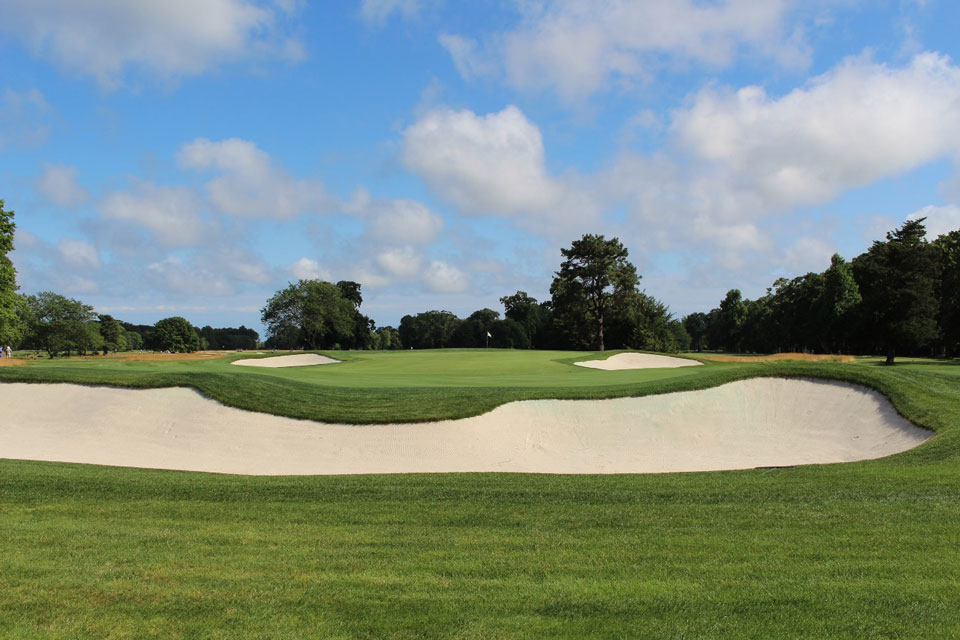
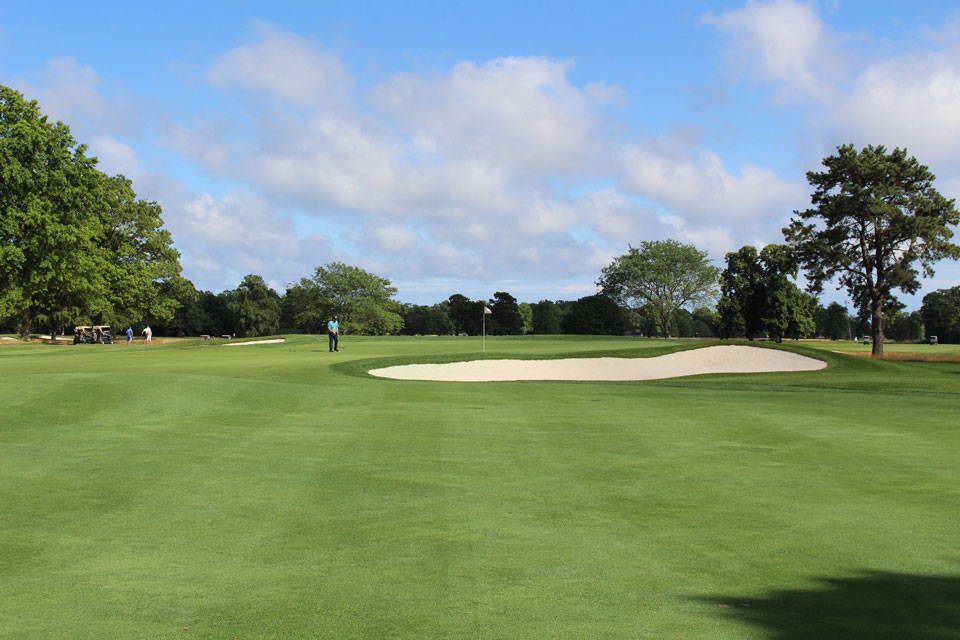
The Reef par-3 as seen head-on from short of the front bunker and from the right-side bailout area. Ridges run behind the trap toward the green and will kick well-placed shots onto the surface.
A more creative option is to play some type of low-trajectory shot that uses the Reef’s contouring as an asset. Beyond the front bunker, the fairway features raised shoulders on both sides that are designed to kick well-placed shots forward onto the green. (Prior to the restoration, a rough-cut on these ridges muted this aspect of the hole’s design.) Shots to the right that fail to carom toward the green might instead spill off farther right into the bailout area. On the left, misses settle into heavy rough. Of course, any shot of this running variety must have enough air underneath to carry the 150-plus yards needed to get over the trap.
+ + + +
Anyone who has played golf on Long Island’s south shore – from beachfront pitch-and-putt to Shinnecock, from county muni to Maidstone – knows the wind never ceases. At times it’s overpowering and unpredictable. Walking off the famed Gibraltar par-3 at Timber Point several years ago, a course veteran broke down the keys to success on the adjacent bayfront holes. “Aim for the bay,” he said, and when the wind on another day reverses toward the water, “aim for the brush.” Though Southward Ho isn’t fully exposed to raw Atlantic gusts like Timber Point is, Tillinghast initiated an intimate dance between his course and the wind, and Young and Weiman helped recreate it by bringing the fairways back to their original size. Tillinghast’s fairway widths, “when combined with the challenging green complexes, allowed for creative shot-making, as with each change in wind direction a veritable new hole was created,” Young says
With no long, forced carries off the tee and no threatening hazards to avoid, the emphasis always remains on the approach shots, no matter which way the wind might shift. On a day where the wind rushes toward the bay, suddenly the par-5s at #10 and #11 play closer to 600 yards, and clearing Hell’s Half Acre on the second shot requires a powerful strike. It pays off later when a tailwind offers a helping hand on the Reef 14th and the grueling par-4s that close the round at holes 16 and 18.
Outside of the seven-hole stretch detailed earlier, there are plenty of shots likely to stick in mind long after a round at Southward Ho has ended. The 142-yard fourth is arguably the club’s best-looking hole, with wispy fescue separating tee from green and five bunkers hugging the putting surface and apron. It breaks from the general north-south hole layout, so accuracy into a crosswind is vital. Misses to the sides must contend with high-faced traps and a green that funnels balls with speed.

Beside the green on the par-3 fourth.
There’s no simple way in on the 15th, a 354-yard par-4 and Southward’s only hole that doglegs to the left. Even with a short iron in hand, the green is a slim and slippery target angled hard to the fairway’s right side. Its front tongue measures less than 10 yards across with two closely cut traps at its sides. Play toward the wider back half knowing that subsequent putts will sprint down the back-to-front slope.
It’s not the looker that #4 is and it doesn’t have its own entries in the Tillinghast history books like Little Tilly and Reef, but the par-3 17th is certainly no afterthought. It’s nearly equal in yardage to the Reef 14th but plays in the opposite direction. Players who take on the short-right bunker might benefit from a generous kick off a downslope in the buffer zone between sand and green. Otherwise, the main impediment is a large left-side trap that presses cheek to cheek against the enlarged green.
The 18th offers a pleasant conclusion despite its understated difficulty. Southward Ho’s windmill sends you off from beyond the trees to the left. Up ahead is a lengthy par-4 that goes back to basics – two powerful shots to cut through the wind and cover the final 431 yards to the pin.
For those who spent their day fighting against Tillinghast’s tide, the straight 18th is a respite from thorny recoveries and shrunken targets. A refreshing finish.
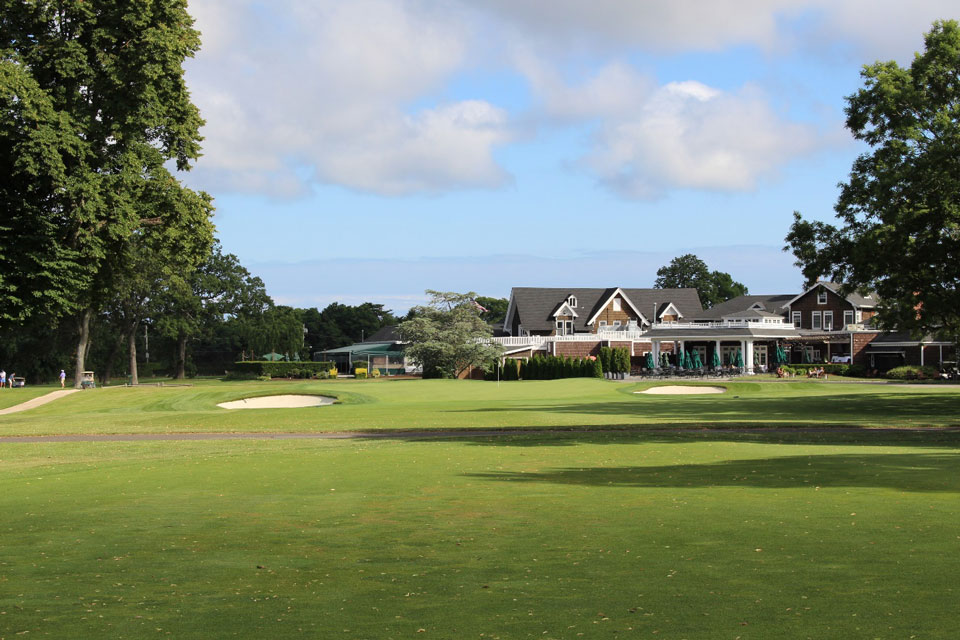
One final approach.







